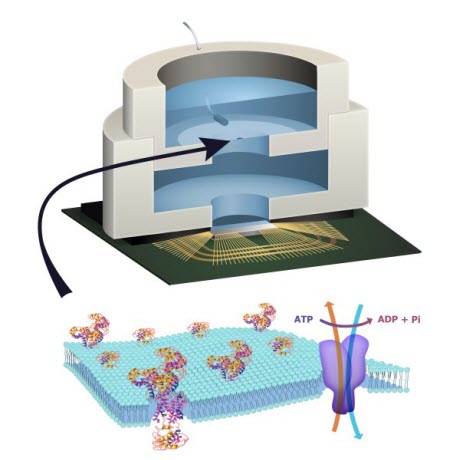 Illustration depicting biocell attached to CMOS integrated circuit with membrane containing sodium–potassium pumps in pore.Image credit: Trevor Finney and Jared Roseman/Columbia EngineeringNewswise — New York, NY—December 7, 2015—Columbia Engineering researchers have, for the first time, harnessed the molecular machinery of living systems to power an integrated circuit from adenosine triphosphate (ATP), the energy currency of life. They achieved this by integrating a conventional solid-state complementary metal-oxide-semiconductor (CMOS) integrated circuit with an artificial lipid bilayer membrane containing ATP-powered ion pumps, opening the door to creating entirely new artificial systems that contain both biological and solid-state components. The study, led by Ken Shepard, Lau Family Professor of Electrical Engineering and professor of biomedical engineering at Columbia Engineering, was published online Dec. 7 in Nature Communications.
Illustration depicting biocell attached to CMOS integrated circuit with membrane containing sodium–potassium pumps in pore.Image credit: Trevor Finney and Jared Roseman/Columbia EngineeringNewswise — New York, NY—December 7, 2015—Columbia Engineering researchers have, for the first time, harnessed the molecular machinery of living systems to power an integrated circuit from adenosine triphosphate (ATP), the energy currency of life. They achieved this by integrating a conventional solid-state complementary metal-oxide-semiconductor (CMOS) integrated circuit with an artificial lipid bilayer membrane containing ATP-powered ion pumps, opening the door to creating entirely new artificial systems that contain both biological and solid-state components. The study, led by Ken Shepard, Lau Family Professor of Electrical Engineering and professor of biomedical engineering at Columbia Engineering, was published online Dec. 7 in Nature Communications.
“In combining a biological electronic device with CMOS, we will be able to create new systems not possible with either technology alone,” says Shepard. “We are excited at the prospect of expanding the palette of active devices that will have new functions, such as harvesting energy from ATP, as was done here, or recognizing specific molecules, giving chips the potential to taste and smell. This was quite a unique new direction for us and it has great potential to give solid-state systems new capabilities with biological components.”
Shepard, whose lab is a leader in the development of engineered solid-state systems interfaced to biological systems, notes that despite its overwhelming success, CMOS solid-state electronics is incapable of replicating certain functions natural to living systems, such as the senses of taste and smell and the use of biochemical energy sources. Living systems achieve this functionality with their own version of electronics based on lipid membranes and ion channels and pumps, which act as a kind of “biological transistor.” They use charge in the form of ions to carry energy and information—ion channels control the flow of ions across cell membranes. Solid-state systems, such as those in computers and communication devices, use electrons; their electronic signaling and power are controlled by field-effect transistors.
Related article: Energy-Generating Cloth Could Replace Batteries in Wearable Devices
In living systems, energy is stored in potentials across lipid membranes, in this case created through the action of ion pumps. ATP is used to transport energy from where it is generated to where it is consumed in the cell. To build a prototype of their hybrid system, Shepard’s team, led by PhD student Jared Roseman, packaged a CMOS integrated circuit (IC) with an ATP-harvesting “biocell.” In the presence of ATP, the system pumped ions across the membrane, producing an electrical potential harvested by the IC.
“We made a macroscale version of this system, at the scale of several millimeters, to see if it worked,” Shepard notes. “Our results provide new insight into a generalized circuit model, enabling us to determine the conditions to maximize the efficiency of harnessing chemical energy through the action of these ion pumps. We will now be looking at how to scale the system down.”
While other groups have harvested energy from living systems, Shepard and his team are exploring how to do this at the molecular level, isolating just the desired function and interfacing this with electronics. “We don’t need the whole cell,” he explains. “We just grab the component of the cell that’s doing what we want. For this project, we isolated the ATPases because they were the proteins that allowed us to extract energy from ATP.”
Related article: Researchers Develop World’s Thinnest Electric Generator
The ability to build a system that combines the power of solid-state electronics with the capabilities of biological components has great promise. “You need a bomb-sniffing dog now, but if you can take just the part of the dog that is useful—the molecules that are doing the sensing—we wouldn’t need the whole animal,” says Shepard.
“With appropriate scaling, this technology could provide a power source for implanted systems in ATP-rich environments such as inside living cells,” added Roseman.
Advanced Lab Management Certificate
The Advanced Lab Management certificate is more than training—it’s a professional advantage.
Gain critical skills and IACET-approved CEUs that make a measurable difference.
The work is funded by the Keck Foundation and the Office of Naval Research.











